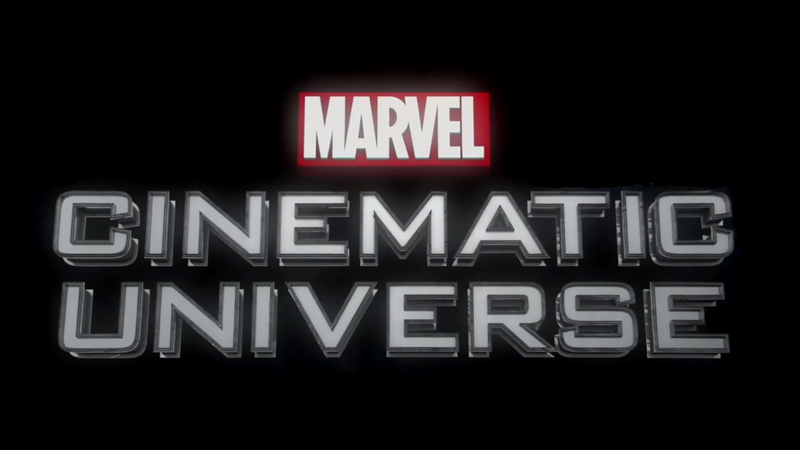Prelude
“Last thing I remember
I was running for the door
I had to find the passage back
To the place I was before
“Relax, ” said the night man
“We are programmed to receive
You can check out any time you like
But you can never leave!”
–Don Henley, Hotel California[i]
Population can be a weird topic to discuss. Or perhaps it just feels like a weird topic. In popular media, it’s primarily the main focus of Malthusian villains like Thanos.[ii] In real life, authoritarian regimes have incorporated bigoted eugenic policies into managing population growth.[iii] Even in regular media discourse, rich people like Elon Musk have made it weird and slightly eugenic again to discuss population.[iv]
Even without the weirdness of fictional and real-world villains owning the population topic, the issue isn’t very intuitive either. Procreation has been going on for millennia, and many would agree that the act behind procreation is one of their favorite pastimes. So how can there be any issues? Key population statistics like fertility rate also make the issue sound more clinical than behavioral.[v] And it is hard to determine a certain deadline for the consequences of a population crisis to take effect, which deprives leaders of the ability to build urgency.
Despite all this, it’s time we normalize the conversation and move away from the traditional ethical potholes that make population a polarizing topic. As many developed countries face both shrinking and slowing population parameters, a lot of what we count on economically and socially could change for the worse.[vi]
At this point, you might be thinking . . . This post is supposed to be about dating apps , no? Well while I don’t plan to give a lesson on the birds and the bees,[vii] the process usually begins with people getting together, building a lasting and stable relationship, and then having kids. This process routinely begins with dating, and dating apps are the predominant private sector response to helping people looking for love. If you want to make the chain from dating to parenting work better, then you must start with making the dating better. Unfortunately, this concept is easier said than done.
To fully head off the pending crisis we need to take a holistic approach. We’ll begin by taking a closer look at the problem in the United States and establish criteria for a good solution. Then, we’ll discuss dating apps and how they conversely solve and exacerbate important dating problems. And finally, we’ll discuss our need for better apps, policies, and dating practices. This combination should build the foundation to address the problem properly.
Three quick things before we begin: 1) You may notice that I quoted a lyric from Hotel California at the start of this section and will quote other songs in the remaining sections. Feel free to think of this as a soundtrack for this post and listen while reading. 2) There will be quite a bit of heteronormative statements about relationships in this post. That is because we’ll be talking about babymaking in quite the traditional sense, which requires a certain tone and approach. 3) I’m aware and know of multiple instances of fertility struggles in my own family and friend group. Please don’t read into the incredibly simplistic way that I talk about having children in this post as unsympathetic to couples facing those struggles. Now that you’ve read my disclaimers, let’s talk about solving one of the most pressing, emerging crises of today. Just, not in a weird way, Ok?
The Problem with Population
“Oh, Father tell me, do we get what we deserve?
Whoa, we get what we deserve”
–Jökull Júlíusson, Way Down We Go[viii]
If you’re not careful, thinking about population can twist your brain into a knot. There are a lot of statistics, and the bits of counterintuitive and circular reasoning will leave you exhausted. Therefore, at the risk of simplifying too much, we’ll try to keep things on the straight and narrow here.
Basically, a lot of economic policies, business plans, and societal norms assume that population will increase over time.[ix] In the United States we fund Medicare, Social Security, and other policies based on that assumption. If you’re forecasting GDP, you start with population growth because more people means more consumption and productivity. There’s a general expectation that we need to provide and pass things down to future generations, which we understand as the obligation of family and social responsibility. Population growth is, in some ways, a societal contract we inadvertently agree to at birth. With that in mind, the United States has never faced a sustained period of population decline or seen this level of slowed population growth in our history.[x] We are not ready for this.
Now you’re probably thinking, “Exactly what do you mean by ‘this’?” Allow me to introduce you to the dependency ratio, also referred to as the age-dependency ratio. The dependency ratio is calculated in different ways at different places, but generally it is this:

The visual is taken from Spinnaker Investment Group. The author has no affiliation with and does not endorse this group.[xi]
The dependency ratio refers to the percentage of the population who are dependent on the output of the working population. The smaller the number, the more resources we have to provide for our dependent communities. The higher the number, the less resources we have to support those communities.
To make the math more intuitive, think of your life as a circle between the numerator and denominator. You begin in the numerator. Once you turn fifteen you remain in the denominator until, Lord Willing, you hit 65 and are once again in the numerator. This is the same for everyone around you. As you entered the denominator, someone left to rejoin the numerator and/or was born as a new addition to the numerator.
Let’s take it a step further. Last time I checked, it takes two people to have a baby. Let’s assume the parents are both in the denominator and can support their numerator newborn. Depending on the age of the newborn’s parents, the child will eventually join their parents in the denominator for a while. Years later, the parents will hit their golden years and join the numerator while the child remains in the denominator for a while longer. The dependency ratio in our three-person population example went from 50% to 0% to 200%. For context, we began with two people supporting one. Probably a bit of strain on resources, but ultimately manageable. Then, we entered a period where none of them were dependent on the other, and resources were used for other things. Lastly, we had one person supporting two people creating an untenable strain on the output of the single person to support the dependent population.
Now, if our three-person population was a four-person population with two parents and two kids, assuming twins, then the dependency ratio goes from 100% to 0% to 100%. And while not ideal, at no point does the dependent population overwhelm the working population numerically. Granted it’s probably not a comfortable situation for resource expenditure but not impossible to manage either.
The four-person population highlights the importance of the replacement rate. It is generally accepted that the birth rate required for a population to at least remain steady is 2.1 births per mother. Two births to replace the parents, and the .1 in case anything truly unfortunate happens to the younger population. But as we saw in the example, this is living on the edge in terms of generating and spending resources. Ideally, the birth rate should be well above the replacement rate, which will allows the dependency ratio to stay as small as practical. This allows us to provide not just more resources for the dependent population but also better quality.
Higher fertility rates and population growth can create a virtuous circle of passing the best down to younger generations. It will also provide economic activity to support the goals of the working population while allowing everyone to age gracefully with dignity and support.
Well . . .
Guess what’s not happening . . .
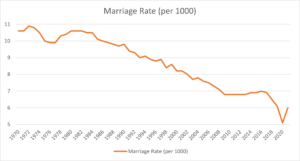
(Data from Centers for Disease Control and Prevention)[xii]
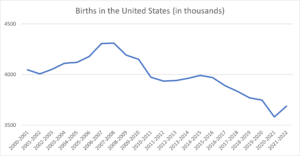
(Data from The Brookings Institution Analysis)[xiii]
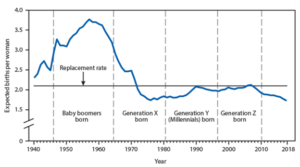
(Chart from Centers for Disease Control and Prevention)[xiv]
Per those three charts, the United States has been driving to a population crisis for decades. Marriage rates are down, births are down, and we have drifted further below the replacement rate. And as for the dependency ratio:
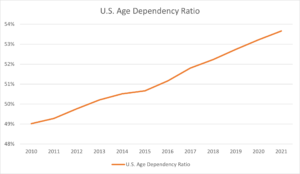
(Data from Our World in Data)[xv]
It is slowly creeping upward.
When will we get to the crisis? I don’t know. What will happen when we get there? Unfortunately, I don’t know exactly that either. Several countries are concerned about needing to pull back on government services and increasing tax burdens to cope with demographic changes.[xvi] The United States has faced a high dependency ratio in the past but that was before government programs like Medicare and multiple tax cuts.[xvii] It is likely that hitting a population crisis will be incredibly stressful and could lead to increased civil unrest.[xviii]
Therefore, we need to stabilize the situation. However, there are positive reasons for a rising dependency ratio. Women gaining more control over their reproductive rights (despite the Supreme Court’s best attempts), increases in life expectancy, and people focusing more on education attainment and careers in early adulthood are all signs of a well-developed economy and society that will increase the dependency ratio.[xix] These are objectively good things, and we don’t want to lose them.
Thus, we need some rules for a good solution. 1) We are only going to use the policy and business tools open to a free society. Absolutely no authoritarian or eugenic strangeness. 2) We are not going to roll back women’s rights. 3) We will not make policies to shorten life expectancy. So, if you’re a Thanos lover . . . Stop it before I call the Avengers. 4) We must craft forward-looking solutions. No going back to earlier stages of the economy or anything else. Simply put, we just need to get people coupling up and committing to each other again and then use our business and public policy solutions to light some candles and set the mood in America. And hopefully, more babies will follow.
Apps to the Rescue?
“You can’t say I don’t love you
Just because I cheat on you
‘Cause you can’t see all I do
To keep you from knowing the things I do”
In a word . . . no. The apps are good at connecting people, especially in niche population segments, and provide a generally safe way of allowing people to meet.[xxi] And I do generally believe that dating apps can have a role in finding your match under the right circumstances. However, dating apps are subject to three important limitations that prevent us from relying on them as a solution.
Limitation #1: Scale. While less traditional households are increasing for many reasons,[xxii] the data still shows that a married woman, or one who has been married, is still far more likely to have a baby than an unmarried one.[xxiii] By simply playing the odds, we want dating apps to strongly contribute to reversing the downward trending marriage rate. Let’s assume a target marriage rate of 10.3, which was the average rate between 1970 and 1990.[xxiv] Between 2015 and 2021, the United States came up short of the target marriage rate by a cumulative ~9 million marriages. That’s about 18 million missing married people.

These statistics may seem hefty, however, there is a surprisingly mathematically feasible solution. In 2022, there were over 91 million single people between 18 and 54 years of age.[xxv] Obviously, there are demographic caveats to consider, but our starting point is five times the number of people needed to close the marriage gap, which is a great start.
The primary issue is dating apps don’t have enough reach. Based on public filings, I estimate that Match Group (which owns Tinder, Hinge, OkCupid, and many more dating apps) and Bumble have a little over 9 million paid subscribers combined.[xxvi] Of course, this number could be larger with non-paying subscribers and smaller for the geographic masking in the public filings. But the focus should be on paid subscribers because they are the most serious users. And even with their focus on finding relationships we’re still only halfway to the goal.
Even if there were 18 million total paying subscribers, having 18 million singles on a dating app isn’t enough to close the gap. Given that only 10% of messages on apps are even replied to,[xxvii] we would need a significantly larger base of singles with the right mixes of sex, gender, and sexual/relationship preferences to have a realistic shot of creating an incremental nine million marriages via the apps. Dating apps help, but they are far from a tech solution for this pending population challenge.
Yet, in American business ethos, we don’t let little issues like “scale” dampen our optimism. Because what if the apps exceed the 10% subscriber market penetration rate to something extremely more helpful soon? The answer: there would be the emergence of yet another limitation.
Limitation #2: Commodifying People and Relationships. Dating apps are designed to prevent the choice overload which occurred during the early days of the internet.[xxviii] At the advent of online dating, users gained access to information about each other via online bulletin boards and chat rooms.[xxix] However, this created a deluge of information that was accepted and rejected by potential mates.[xxx] Choice overload, which is an inability to make decisions because of too much information, became the direct result as people attempted to process this information on their own. [xxxi]
Early dating sites addressed choice overload by focusing on matching people by using questionnaires to assess potential compatibility between its users.[xxxii] For lack of a better term, this tactic was used to “weed out” the possibility of matching two strangers with nothing in common. Let’s call this the “Matching Approach.” The Matching Approach ran into challenges because online dating was limited by stigma in the early days.[xxxiii] But over time, the stigma around online dating dropped, and user adoption grew.[xxxiv]
In response to user growth, dating apps switched from using the Matching Approach to providing a seemingly endless stream of options (the “Optionality[xxxv] Approach”).[xxxvi] Instead of checking for compatibility, the Optionality Approach focuses on curating superficial information, like education, job, and hobbies, and presenting users to each other based on algorithmic grouping and ranking based on these surface-level preferences.[xxxvii] While the Matching Approach alleviates choice overload by eliminating information, the Optionality Approach creates a cushion from choice overload for the user.[xxxviii] Under the Optionality Approach, users never feel the full weight of making a single choice because they have a seemingly endless pipeline in the app to fall back on. By always having the option to swap out, there’s no choice overload from the flood of user information.
However, this approach causes issues. In essence, the Optionality Approach’s superficial foundation turns dating into an entirely reductive experience by limiting the presentation of a person to their highest-level traits. Additionally, the process is gamified, which was started by Tinder’s swipe left/swipe right functionality.[xxxix] Thus, the dating apps turn dating into more of an online shopping experience.[xl] And because this process generally starts with superficial information that isn’t distinctive from other users, dating app subscribers become a commodity product akin to oranges, t-shirts, or any other highly comparative, indistinct products one would find on Amazon.
This commodification can extend beyond the apps and into real life. Users begin commodifying themselves by believing the superficial dating app information reveals their best traits. Soon, this misunderstanding from the app becomes the basis of a personality they think will make them more desirable.[xli] Even worse, users start commoditizing their own relationships with significant others even in advanced stages of a relationship.[xlii] In other words, when users start a relationship like an Amazon purchase, that relationship could consistently feel fungible to both parties. For context, only 10% of marriages start online.[xliii] And wouldn’t it be unsettling to marry and have kids with a partner who could return you to an Amazon locker at any time?
Limitation #3: Monetization is King. No need to belabor this point. Everyone knows intuitively that dating apps are here to make money, and this creates an inherent conflict of interest with getting people together, which could lead to them deleting the apps. Dating apps engage in a bevy of tiered offering tactics to entice paid subscribers by offering features like priority messaging, as well as boosts for your profile to remain ahead of other users.[xliv]
The only aspect to add is how well the Optionality Approach suits the dating apps’ monetization needs. By commodifying people and relationships and creating user comfort with a continuous stream of dating options, the Optionality Approach essentially all but ensures a process of user acquisition, churn, and return that can be a monetization growth engine. Essentially, the dating apps by design make it extremely easy and lightly encourage users to avoid sticking with their decision in a partner at any relationship stage. When the couples call it quits, both could start spending money on the apps again. The Optionality Approach creates a cycle of deleting and reinstalling the app, which brings paid subscribers back once again. If enough time passes between delete and download, then users would be excited to spend on new features they didn’t notice before and fail to notice price increases on pre-existing features. Compared to how the Matching Approach might work, the Optionality Approach is a winner for monetization-focused executives.
And this focus on monetization will only increase in the future. North American paid subscriber growth on Bumble and Match Group apps have slowed and financial results are slowing behind them.[xlv] This has not scared Wall Street yet, but as Morgan Stanley notes, this is because significant revenue growth can be gained by focusing on monetization rather than user growth.[xlvi] This means dating apps will only get more sophisticated at extracting value from users as it feeds and re-feeds us through its Optionality Approach funnel.
Ok . . . Things are a little dark right now.
But come on! This is the Real Question after all. And you know I wouldn’t leave you without a solution.
Better Apps
“If you are what you say you are . . . a superstar
Then have no fear, the camera’s here
And the microphones
And they wanna know . . .”
–Lupe Fiasco, Superstar[xlvii]
The dating apps have serious limitations, but even in their current state, they can play a healthy role in dating if users account for the scale limitations, commodity effects, and monetization focus. However, dating apps have an opportunity to simply get better by adopting and expanding on the Matching Approach.
If the net effect of the Optionality Approach is to deprive the dating process of its humanity, then theoretically a better dating app will re-install that humanity and create real bonds for people to build lives around. The Matching Approach gives us the best chance at this if we match people based on the right things. Since the right thing here is seemingly love, then we’ll need a definition.
Fortunately Simon May, a philosopher, gives an operative definition of love that could form the foundation for a stronger app. May, who chronicles the definition of love throughout human history, argues that people generally should look for “ontological rootedness.”[xlviii] Ontological rootedness is “the rapture we feel for people and things that inspire in us the hope of indestructible grounding for our life. It is a rapture that sets us off on- and sustains – the long search for a secure relationship between our being and theirs.”[xlix] According to May, ontological rootedness “give[s] our existence solidity and validity; to deepen the sensation of being; to enable us to experience the reality of our life as indestructible . . ..”[l] Both people deliver and receive this feeling of “solidity and validity” in each’s own lives (e.g., activities, needs, strengths, vulnerabilities, etc.) creating a healthy balance that fosters and leads to deep bonds, intimacy, and other things we typically associate with romantic love.
For society, a dating app with a Matching Approach focused on ontological rootedness could inspire more marriages and thereby lead to more kids. It would be total speculation on whether an app like that could reach the scale needed to fully solve the problem, but dating apps that meaningfully help would be great to have in staving off the emerging population problem.
If it is possible (and believe me it is beyond this strategist’s purview to know for sure) to build this type of app, then it would be truly helpful and marketable to people who are looking to find deep partnerships. I would even speculate that it would be more valuable and profitable than the Optionality Approach’s monetization funnel.
Better Policy
“It’s not that we don’t care
We just know that the fight ain’t fair
So we keep on waiting (waiting)
Waiting on the world to change”
–John Mayer, Waiting on the World to Change[li]
Governments around the world turn to pronatalist policies to address population concerns. These policies include paid family leave, universal childcare, and other topics to ease the nuances of parenting. Countries outside of the United States also build these policies on top of robust government health insurance programs. For example, Hungary grants paternal leave for up to three years with some level of payment for wages, and Poland provides direct cash payments for children.[lii] However, these policies have not returned countries to the replacement rate, and population issues have only worsened in certain Asian countries, despite long-standing pronatalist policies.[liii]
With this in mind, staunch critics will look at this and say, “Well pronatalist policies are expensive and don’t work. So, we shouldn’t use them.”
I take the opposite approach and wonder, “Wow how much worse would the population problem be without these policies?”
While pronatalist policies are not the silver bullet for population concerns, it would behoove U.S. pursue them. Considering the lack of universal health insurance, universal childcare, and a reduction in the child tax credit,[liv] the United States is already behind the curve on pronatalist policies. As other financial stressors such as housing costs and student loans mount against child rearing,[lv] avoiding pronatalist policies because they are not perfect solutions only creates a worse situation. On top of that, U.S. politicians have barely started engaging on the topic outside of a few Democrats and Independents alluding to people needing to date more[lvi] or Republicans approaching this as a gender roles and moral values debate.[lvii] For the U.S., it is a silent problem on a weak foundation, and that should not be allowed to continue.
The U.S. government should do its part by enacting pronatalist policies and proactively showing leadership on the topic. However, as alluded to above, pronatalist policies need to be more holistic. Governments are used to pulling policy levers to incentivize people to buy or do something. If a government wants people to buy new cars, they provide an aggressive tax credit to make it happen. However, with pro-natalist policies, we’re talking about the economics of a brand new human who will rely on taxpayers’ purse strings for a while. This is very different from incentivizing people to buy something that has a 2-year warranty attached.
Governments must not only incentivize having kids but also enact policies that address the broader responsibility of taking care of a child. Addressing things like housing costs, student loans, health insurance, and other general threats to personal stability will give people not only economic opportunity, but also the self-efficacy to confidently bring children into this world while facing unknown challenges and benefits. Despite the attention placed upon folks who have given up on having kids, most Americans still desire to start families and have large families too.[lviii] However, governments need to give them something to work with to at least get back to the replacement rate.
Better . . . Well . . . Better Us
“One love, one game, one desire
One flame, one bonfire, let it burn higher
I never show signs of fatigue or turn tired
‘Cause I’m the definition of tragedy turned triumph
. . .
The only thing I hear is my heart, I’m inspired
By the challenge that I find myself standing eye to eye with
Then move like a wise warrior . . . ”
Getting better apps would be great, and getting better policies are a requirement. However, this is not a problem of only business models and economic incentives. It is also a problem of individual behavior within the dating market itself. To run the final leg of this solution, we must address how dating app users (really the dating population in general) and their support networks (i.e., family, friends, etc.) approach this problem in general. Now, I’m not trying to join the scores of dating experts claiming to know exactly how to make a relationship work when someone is into you. There’s a lot of content you can research with caution just like any other type of information.[lx] However, I am a strategist. Understanding the root causes of difficult problems, mastering confusion, and pushing decisions are my specialty. Therefore, I will briefly offer three suggestions to help anyone swimming in the dating pool without a life jacket to maneuver these waters.
First, we all need to make sure that we’re focusing on the right things. It is nearly impossible to get through a tough problem without focusing on objectives that will lead to a solution. Second, we must do a resiliency check because that is integral to dealing with confusing situations like dating. And lastly, we must make confident decisions about partners in order to increase the marriage rate and the birth rate.
Focus: I’ll reintroduce ontological rootedness here. I get it. This definition of love from the Better Apps section might sound a bit technical and not consistent with the common discourse on what love is.[lxi] However, it is very approachable and very human. It allows for self-reflection about what daters like and don’t like about their own lives and provides a discussion framework for daters to enlist wisdom and discernment from their support networks.
Ontological rootedness has the added benefit of defying the Optionality Approach. By focusing on what makes a dater feel solid and valid in their lives, there is a clear path to focus away from superficial information like education, occupation, and hobbies. And what’s left in its stead are factors leading to real love and lasting partnerships. Ontological rootedness also allows daters to put existing partner criteria and even sexual attraction into the right context, which can lead to better dating decisions in general.
Even if your philosophy on love doesn’t comport with ontological rootedness, perhaps it’s time to re-evaluate your definition. The fact remains focusing on superficial information leaves daters stuck in the Optionality Approach on the apps, as well as in the real world. Focusing on what makes daters feel love and lets them know that their love is being accepted provides a clearer path to lasting partnership for the dater.
Resiliency: Let’s keep in mind, dating can be fun and extremely rewarding. But it is also a game that is built to hurt. To quote May, who partially quoted Ovid, “‘Love is a kind of war, and no assignment for cowards’, but one can excel at it given talent, skill, cunning, enthusiasm – and self-restraint.”[lxii] Resiliency is one of those skills for sure. When I talk about resiliency, I talk about the topic with full sympathy for those dealing with traumas that act as barriers to seeking a partner. No one should engage in doing this without ensuring their mental health and physical safety as a priority. For those of us ready to play, at some point we have to dig in and find resolve.
Resiliency has many facets. However, we’ll talk about it in two forms. First is the resiliency to stay out there. The goal is to not stay in the dating game at the expense of damaging your mental or physical health. But to remain resilient despite common hurts and previous dating setbacks. One author referred to this as putting on her Braveheart war paint and staying on the battlefield, but the same author wrote about the need for strategic breaks, avoiding burnout, and relying on support networks to keep going.[lxiii] Personally, I do the same while focusing on the positives and lessons learned to keep dating as enjoyable as possible. Some of these lessons help me connect to my own family and friends better, which is a huge reward on its own.
Second is the resiliency needed to stand by decisions. The Optionality Approach and its reliance on superficial traits make it easy to reverse a decision to build a partnership. Now obviously, there are good reasons to end potential partnerships, but the key is to not give up simply because there are other options. The Optionality Approach encourages thinking that allows perfect to become the enemy of good while sowing doubt into the most confident decisions. However, at the right intersection of judgment, intuition, and resiliency, we can find the resolve to prosper in good decisions despite reasonable shortcomings in a partner.
However, the key here is making confident decisions . . .
Decision-Making: For decisions to stick, we need to be confident that we’ve made the right decisions and make them easy to implement. The Optionality Approach makes decision-making hard enough, but we also have the weight of marriage history working against us. This history is steeped in extreme patriarchy, consumerism, and antiquated courtship practices.[lxiv] Thus, society has trained us to let men essentially pick whomever for a partner without outside judgment, and women to only accept mates that are of higher economic standing. For reference, love didn’t enter the marriage picture until the Victorian Era, which started in the 1830s.[lxv]
Advances for women like increasing reproductive rights, career focus, and educational attainment that outpaces men[lxvi] means meeting the aforementioned historical criteria is becoming increasingly difficult. And this is not a uniquely Western occurrence. Similar circumstances in South Korea have taken a heavy toll on birth rates.[lxvii] Also, note how well the historical criteria fit into the Optionality Approach. This means resetting the historical criteria and replacing it with modern day thinking is key to getting confident and easily implemented decisions.
And here is where we put it all together. Making confident decisions means having a) the right criteria, b) meeting the meaningful parts of those criteria, and c) having a workable course of action. The right criteria will come from a dater’s focus on the right things, which are the dater’s personal factors that lead to ontological rootedness. If you have picked up on this yet, an argument in this blog is that education, job, and hobbies are at best correlated with but are otherwise superficial to ontological rootedness. A criterion based on ontological rootedness can also defeat the historical criteria and the Optionality Approach. Then, along with intuition and judgment, resiliency lays the foundation for knowing when the material elements of a dater’s ontological rootedness criteria are authentically met.
Finally, a workable course of action is built when daters and their support networks are more accepting of partnerships outside of the historical criteria. This brings less overt criticism into the process, which makes sticking with a good partner or leaving a bad partner easier to do. The dater can then allow economics, education, and hobbies to take proper place in support of ontological rootedness rather than be considered the source of it.
Hopefully, this will give daters and their support networks everything needed to look at other options and simply say, “Nope, I’m done.” Then, put the dating apps and the Optionality Approach down for good.
And then, if everything else is in place, please have lots of babies.
Conclusion
“Keep your heart, Three Stacks, keep your heart
Hey keep your heart, Three Stacks, keep your heart
Man these girls is smart, Three Stacks, these girls is smart
Play your part, play your part”
–Andre 3000, Int’l Players Anthem (I Choose You)[lxviii]
This topic and its questions are way too big for a blog. However, one major takeaway should be that a population crisis requires all of us to fix it. It is bigger than dating apps, but the apps can be part of the solution. It is bigger than pronatalist policies, but those are required parts of the solution. It is bigger than just being better daters and support networks, but those are critical as well.
The key here is that as large and bleak as this problem looks . . . We can do this. We don’t need utopia or perfection to solve this issue either. Things were certainly not perfect before when the population was growing and stable, and it still happened.
We just need to be forward-thinking, be leaders, act on the right things, and value our connections to each other as people over the dark legacies from the past and monetization goals of today. All we must do is choose a new way to start.
Endnotes:
[i] Felder, Don, Frey, Glenn, and Henley, Don. “Hotel California.” Hotel California. Asylum Records. 1976. YouTube. https://youtu.be/09839DpTctU?feature=shared
[ii] https://carnegiemnh.org/defeating-thanos-and-his-malthusian-mission-of-population-control/#:~:text=Over%20the%20course%20of%20many,choice%20requiring%20Thanos’%20strong%20will
[iii] https://gpb.pbslearningmedia.org/resource/amex32ec-soc-eugenicsnazi/american-eugenics-and-the-nazi-regime-the-eugenics-crusade/
[iv] https://www.wired.com/story/elon-musk-population-crisis/ and https://www.telegraph.co.uk/family/life/pronatalists-save-mankind-by-having-babies-silicon-valley/
[v] There is evidence that environmental factors have impacted male fertility worldwide, but the research behind this blog has not produced anyone citing that as the main driver of the current population challenges. https://youtu.be/oILTOL7L0sU?feature=shared
[vi] https://www.youtube.com/watch?v=gomrMfWrPz8&list=PLCjwFLItEzuGBH2Z38x6rgmG8oWUCaXxv&index=37
[vii] If you happened to end up here without a working understanding of how people make babies, please consult a responsible adult in your life about the virtues and responsibilities of sex and intimacy.
[viii] Júlíusson, Jökull. “Way Down We Go.” Way Down We Go. Elektra Records and Atlantic Records. 2015. YouTube. https://youtu.be/0-7IHOXkiV8?feature=shared
[ix] https://youtu.be/9UQQ-NfcoWE?feature=shared
[x] https://www.statista.com/statistics/1067138/population-united-states-historical/
[xi] The Spinnaker Group did not invent the dependency ratio.
[xii] https://www.cdc.gov/nchs/data/hestat/marriage_rate_2018/marriage_rate_2018.htm and https://www.cdc.gov/nchs/fastats/marriage-divorce.htm
[xiii] https://www.brookings.edu/articles/new-census-estimates-show-a-tepid-rise-in-u-s-population-growth-buoyed-by-immigration/#:~:text=In%20the%20newly%20released%20census,to%20245%2C000%20for%20natural%20increase
[xiv] https://www.cdc.gov/mmwr/volumes/69/wr/mm6901a5.htm
[xv] https://ourworldindata.org/grapher/age-dependency-ratio-projected-to-2100?time=2010..2021&country=~USA
[xvi] See note 6.
[xvii] https://ourworldindata.org/grapher/age-dependency-ratio-projected-to-2100?time=earliest..2021&country=~USA
[xviii] https://youtu.be/tVPqTG-hOIo?feature=shared (citing specifically unrest regarding France’s pension reform).
[xix] https://www.youtube.com/watch?v=PrezH2SlP0Y&list=PLCjwFLItEzuGBH2Z38x6rgmG8oWUCaXxv&index=41
[xx] Legend, John. “Number One.” Get Lifted. Sony BMG Music Entertainment. 2004. YouTube. https://youtu.be/E_doaAwGa0A?feature=shared
[xxi] https://youtu.be/-bcKRd_lfAg?feature=shared
[xxii] https://www.pewresearch.org/social-trends/2018/04/25/the-changing-profile-of-unmarried-parents/
[xxiii] https://www.cdc.gov/mmwr/preview/mmwrhtml/mm6426a7.htm
[xxiv] https://www.cdc.gov/nchs/data/hestat/marriage_rate_2018/marriage_rate_2018.htm , https://www.cdc.gov/nchs/fastats/marriage-divorce.htm , and internal analysis.
[xxv] https://www.census.gov/newsroom/stories/unmarried-single-americans-week.html
[xxvi] https://www.sec.gov/ixviewer/ix.html?doc=/Archives/edgar/data/0000891103/000089110323000013/mtch-20221231.htm , https://www.sec.gov/ixviewer/ix.html?doc=/Archives/edgar/data/1830043/000095017023005080/bmbl-20221231.htm , https://www.pewresearch.org/internet/2023/02/02/the-who-where-and-why-of-online-dating-in-the-u-s/#:~:text=With%20such%20a%20diverse%20array,more%20dating%20apps%20or%20sites. , and internal analysis
[xxvii] Starbuck, Margot. The Grown Woman’s Guide to Online Dating: Lessons Learned While Swiping Right, Snapping Selfies, and Analyzing Emojis. Narrated by Lisa Larsen. Thomas Nelson. 2020. Audible App. Chapter 2 at 5:00-5:25.
[xxviii] https://youtu.be/mW9xvSi-MWs?feature=shared
[xxix] See note 21.
[xxx] See note 21.
[xxxi] https://thedecisionlab.com/biases/choice-overload-bias and See note 21.
[xxxii] See note 21.
[xxxiii] See note 21.
[xxxiv] See note 21.
[xxxv] Borrowing some language from the Modern MBA, see note 28.
[xxxvi] https://youtu.be/mW9xvSi-MWs?feature=shared
[xxxvii] https://youtu.be/mW9xvSi-MWs?feature=shared
[xxxviii] https://youtu.be/mW9xvSi-MWs?feature=shared
[xxxix] https://youtu.be/mW9xvSi-MWs?feature=shared
[xl] Starbuck at note 27 at Chapter 2 at :40-:56.
[xli] See note 21.
[xlii] See note 21.
[xliii] https://www.pewresearch.org/short-reads/2023/02/02/key-findings-about-online-dating-in-the-u-s/
[xliv] https://www.wsj.com/business/dating-apps-hinge-tinder-subscription-prices-c9a03b1
[xlv] https://www.sec.gov/ixviewer/ix.html?doc=/Archives/edgar/data/0000891103/000089110323000013/mtch-20221231.htm and https://www.sec.gov/ixviewer/ix.html?doc=/Archives/edgar/data/1830043/000095017023005080/bmbl-20221231.htm
[xlvi] https://www.morganstanley.com/ideas/online-dating-2030
[xlvii] Lupe Fiasco. “Superstar (feat. Matthew Santos).” The Cool. Atlantic Recording Corporation. 2007. YouTube. https://youtu.be/hVkBlsgthLg?feature=shared
[xlviii] May, Simon. Love: A History. Yale University Press. 2011
[xlix] May at 5.
[l] May at 5-6.
[li] Mayer, John. “Waiting on the World to Change.” Continuum. Aware Records. 2006. YouTube. https://youtu.be/oBIxScJ5rlY?feature=shared
[lii] https://youtu.be/gomrMfWrPz8?feature=shared
[liii] See note 53.
[liv] https://www.nytimes.com/2022/11/25/us/politics/child-tax-credit.html
[lv] https://www.bloomberg.com/news/articles/2022-03-23/why-aren-t-millennials-buying-home-4-charts-explain
[lvi] https://www.the-independent.com/news/world/americas/us-politics/bernie-sanders-covid-relief-bill-dating-b1813397.html
[lvii] https://www.focusonthefamily.com/marriage/american-beliefs-that-weaken-marriage/
[lviii] https://news.gallup.com/poll/164618/desire-children-norm.aspx#:~:text=Combined%2C%20more%20than%20nine%20in,wish%20they%20had%20(7%25).&text=Americans%20say%20the%20ideal%20number,found%20since%20the%20late%201970s , https://news.gallup.com/poll/511238/americans-preference-larger-families-highest-1971.aspx#:~:text=Bar%20chart%20showing%20parental%20status,8%25%20do%20not%20want%20children.
[lix] Black Thought. “The Fire.” How I Got Over. Aware Records. 2006. YouTube. https://youtu.be/cCrm-6sS3II?feature=shared
[lx] https://youtu.be/VnLqBXhzK_o?feature=shared
[lxi] https://youtu.be/c_v3yvYv24Y?feature=shared
[lxii] May at pg. 75.
[lxiii] Starbuck at Chapter 30.
[lxiv] See note 21.
[lxv] See note 21.
[lxvi] https://www.brookings.edu/articles/boys-left-behind-education-gender-gaps-across-the-us/
[lxvii] https://www.youtube.com/watch?v=etq5gOc4F0M&list=PLCjwFLItEzuGBH2Z38x6rgmG8oWUCaXxv&index=39
[lxviii] Andre 3000. “Int’l Players Anthem (I Choose You).” Underground Kingz. Jive Records. 2007. YouTube. https://youtu.be/WG3qnNkmqvU?feature=shared



